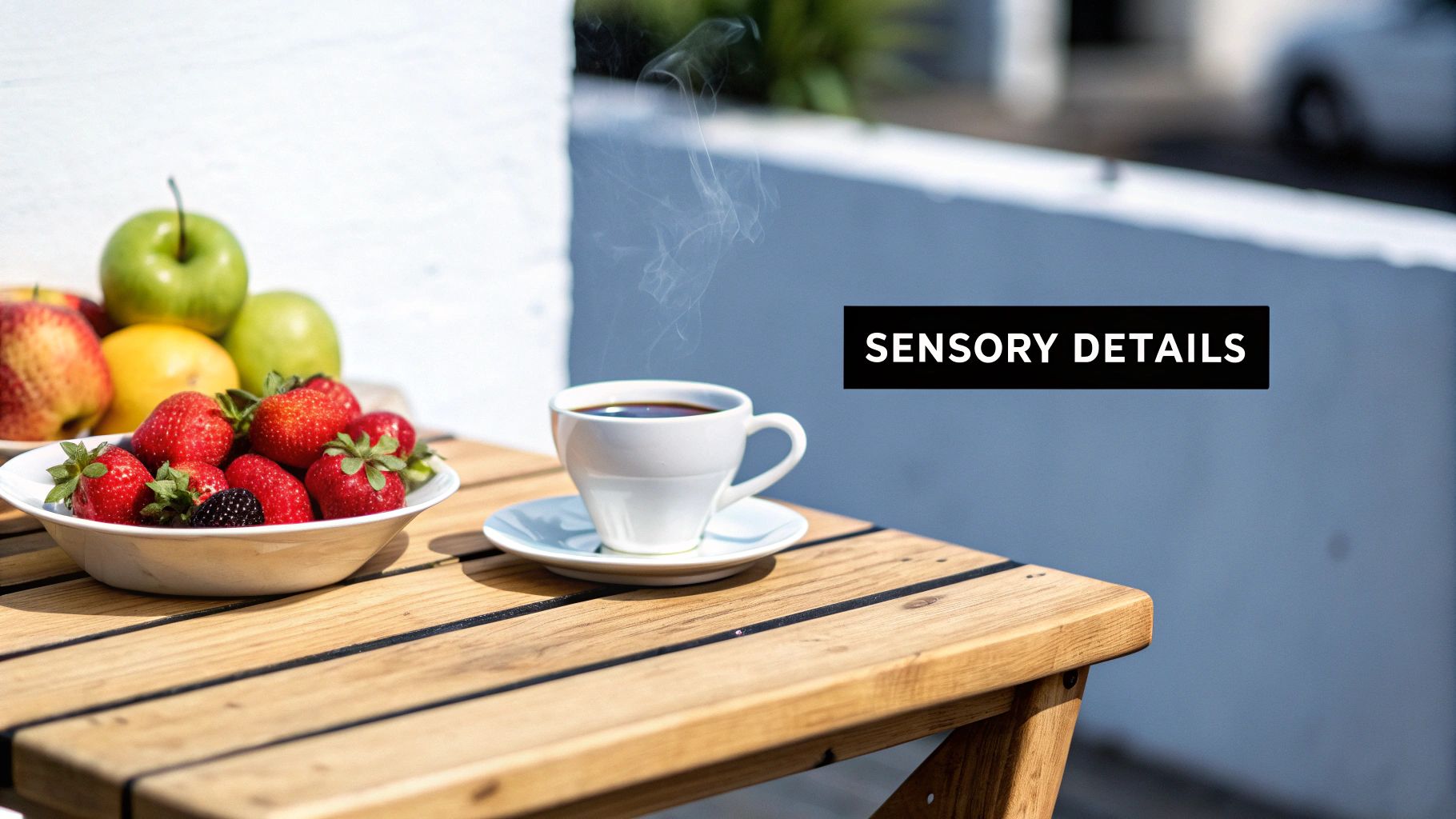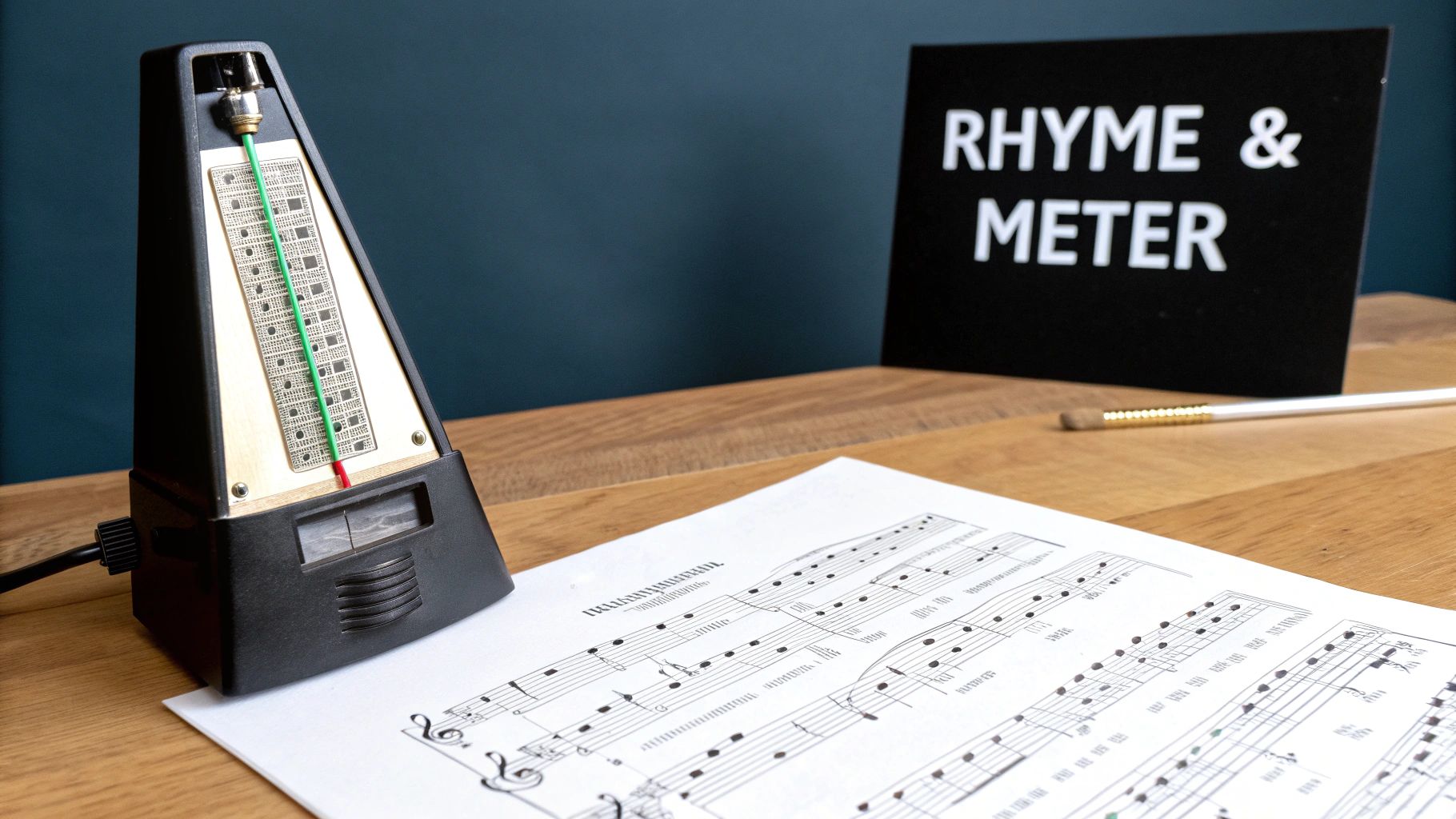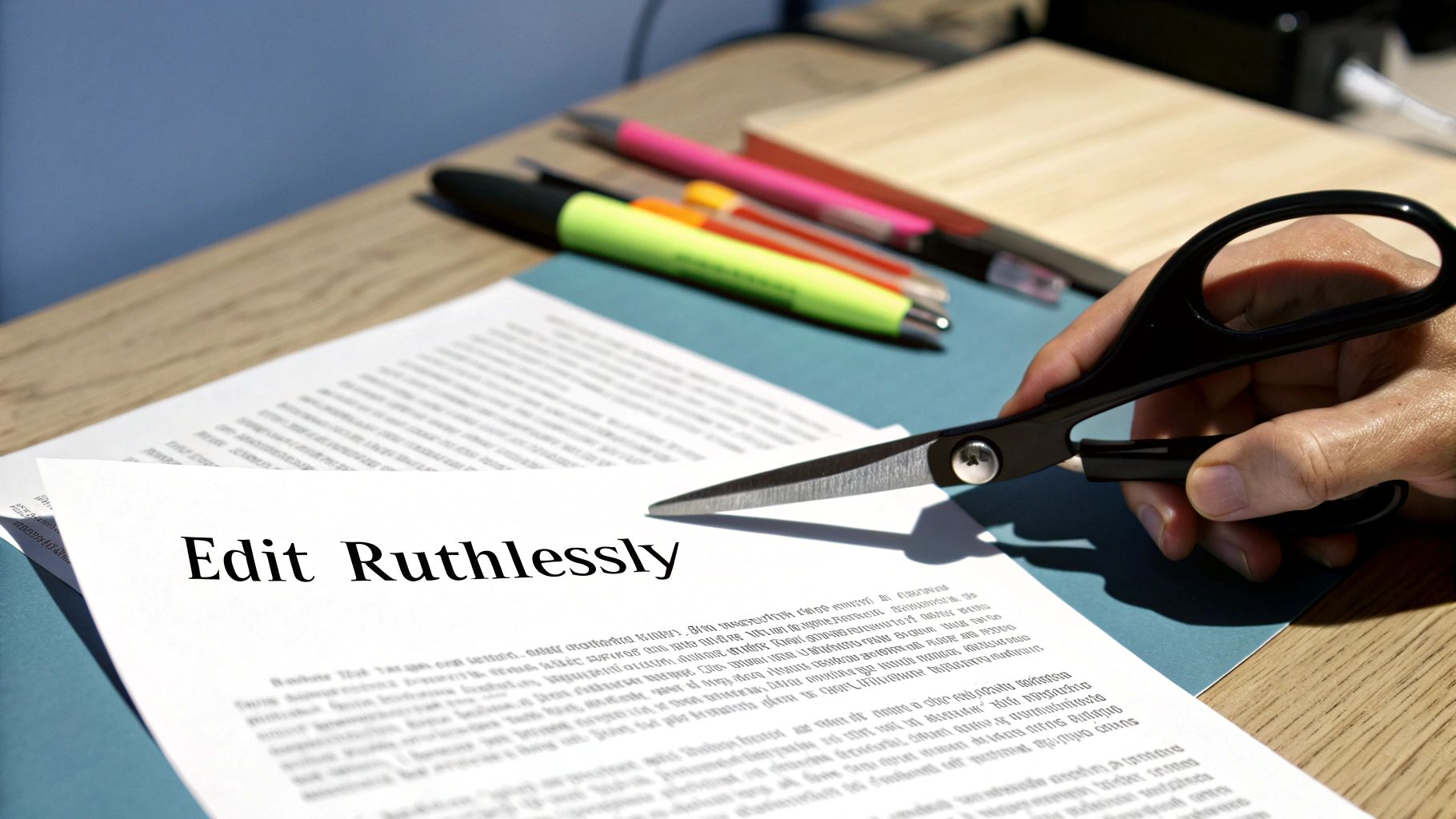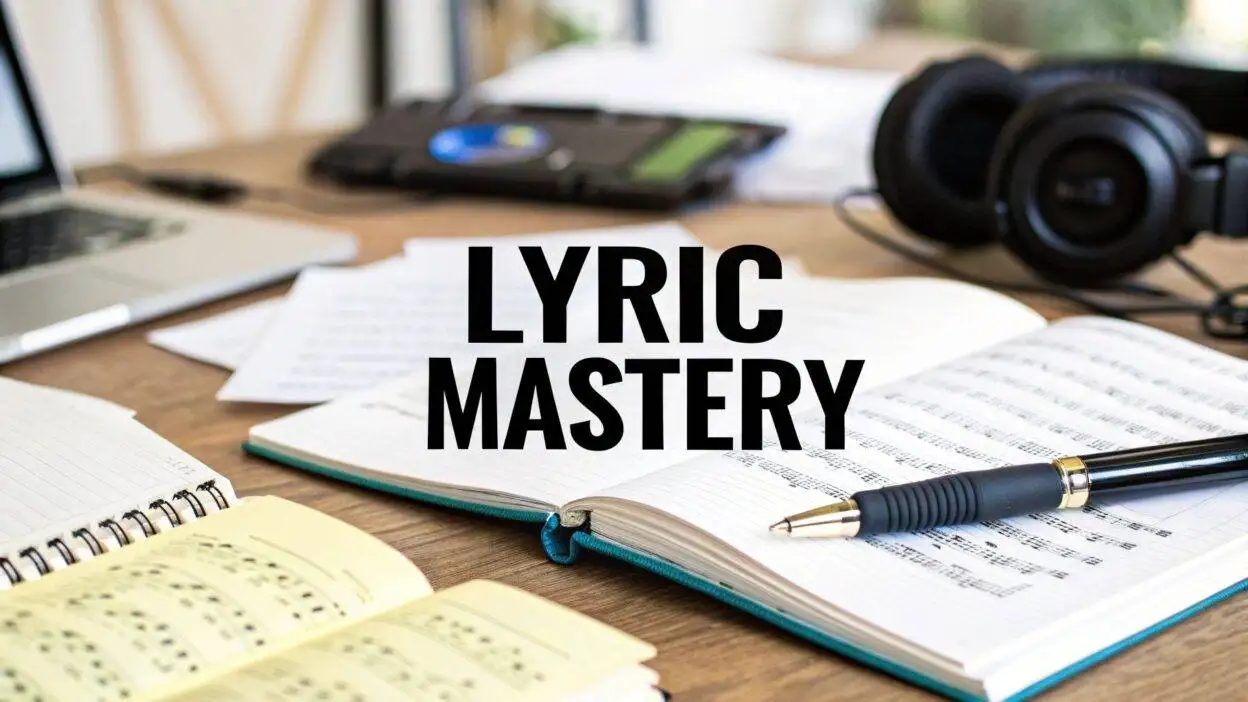Every great song starts with an idea, a fleeting emotion, or a powerful story waiting to be told. Transforming that spark into compelling lyrics that resonate with listeners is an art form. The difference between a good song and a timeless classic often lies in the craft of lyricism, the ability to choose words that not only fit a melody but also create vivid worlds, evoke deep emotions, and stick in the listener's mind long after the music stops.
This guide moves beyond generic advice to deliver practical techniques you can apply immediately. Mastering the fundamentals of lyric writing is a cornerstone of success for any musician, from beginner songwriters to independent artists. This isn't about finding a magic formula; it's about adding powerful, practical methods to your creative toolkit.
Here, we will break down seven actionable lyric writing tips used by professional songwriters. We will cover everything from starting with a strong hook and using concrete imagery to mastering rhyme schemes and editing ruthlessly. Each technique is designed to help you write with more authenticity, impact, and confidence. Get ready to turn your raw ideas into lyrics that don't just get heard, but get felt.
1. Start with a Strong Hook: Your First Impression
A song's opening line is its first, and often most critical, handshake with the listener. This lyrical hook is the doorway into your song’s emotional landscape or narrative. It doesn't just catch the ear; it captures the imagination, establishes the core theme, and creates an immediate connection. Think of it as your song's "thesis statement," distilled into a memorable, punchy phrase that makes a promise to the listener.
A strong hook sets the stakes and makes the audience want to know what happens next. It’s the difference between a listener skipping to the next track or leaning in, intrigued. This initial engagement is vital for holding attention in a world of endless choices.
How to Craft a Powerful Hook
Developing this skill is one of the most valuable lyric writing tips for any songwriter. Don't settle for the first idea that comes to mind; actively brainstorm and test different approaches to find the most compelling opening.
- Ask a Provocative Question: Questions immediately engage the listener's curiosity. Consider the directness of Lionel Richie's "Hello, is it me you're looking for?" or Queen's "Is this the real life? Is this just fantasy?" These lines pull the listener directly into the song's central conflict or theme.
- Present a Vivid Image: Paint a picture that grounds the listener in a specific time and place. Green Day’s "Boulevard of Broken Dreams" opens with, "I walk a lonely road, the only one that I have ever known," instantly creating a scene of isolation that defines the entire track.
- Make a Relatable Declaration: Start with a statement of universal truth or feeling. Bill Withers' "Ain't No Sunshine" begins with a simple, powerful declaration of loss that resonates deeply with shared human experience.
Key Insight: A hook isn't just a catchy phrase; it’s a commitment. It must accurately represent the tone and subject matter of the song that follows. A dramatic, mysterious hook should lead to a song that delivers on that sense of intrigue.
To practice, dissect the opening lines of your favorite songs. Analyze why they work and how they set up the rest of the lyrical journey. The goal is to find a line so intriguing that listeners feel compelled to stick around for the answer.
2. Write from Personal Experience: The Heart of Authenticity
The most powerful songs often come from the most personal places. Writing from personal experience means mining your own life, emotions, and observations to create lyrics that are both authentic and deeply relatable. This approach turns your unique history, relationships, struggles, and triumphs into universal stories that connect with listeners on a fundamental human level.

This method, a cornerstone for artists like Adele and Taylor Swift, infuses your work with a genuine emotional core that is impossible to fake. When you write what you know, your lyrics gain a specific, lived-in quality that makes them resonate far more than generic platitudes. This is one of the most effective lyric writing tips for building a true connection with your audience.
How to Tap into Your Personal Story
Turning raw life events into polished lyrics requires a blend of vulnerability and craft. It’s about finding the universal truth within your specific circumstances and translating that feeling into song.
- Keep an Experience Journal: Dedicate a notebook to jotting down daily feelings, interesting conversations, or vivid memories. This becomes a raw-material resource for future songwriting sessions, capturing emotions in their most immediate form.
- Transform Specifics into Themes: Your personal breakup is the specific event; the universal theme is heartbreak, loss, or betrayal. Frame your personal story in a way that allows listeners to see their own experiences reflected in yours, like Adele did on her album 21.
- Embrace Vulnerability: Authenticity requires honesty. Don't be afraid to explore difficult emotions or unflattering moments. Johnny Cash’s iconic cover of "Hurt" is powerful precisely because of its raw, unfiltered look at regret and mortality.
- Use Sensory Details from Memory: Ground your lyrics in reality by incorporating specific sensory details. What did the room smell like? What was the weather? These small, concrete details make a memory feel immediate and real to the listener.
Key Insight: Personal experience is not a diary entry; it is a starting point. The songwriter's job is to shape that raw material into a structured, artistic expression that communicates a core emotion or idea effectively to an audience.
By drawing from your own life, you ensure your lyrics have a foundation of truth. This authenticity is what allows a song to transcend the personal and become a shared anthem for listeners everywhere.
3. Use Concrete Imagery and Sensory Details
Great lyrics don't just tell you about a feeling; they make you experience it. This is the power of concrete imagery and sensory details. Instead of presenting abstract ideas like "love" or "sadness," this technique grounds your listener in a tangible, physical world. By engaging the senses – sight, sound, smell, taste, and touch – you transform your song from a statement into a scene the listener can step into.

This method is one of the most effective lyric writing tips because it activates the listener's imagination, creating a personal and memorable connection. A line like "I feel sad" is easily forgotten, but Tracy Chapman’s vivid picture in "Fast Car" – "You got a fast car, I got a plan to get us out of here" – instantly paints a world of desperate hope and escape that resonates deeply.
How to Evoke the Senses in Your Lyrics
Mastering this skill involves moving from the general to the specific. It’s about showing, not just telling. Legends like Bob Dylan and Joni Mitchell built their careers on their ability to create entire worlds with just a few carefully chosen words.
- Replace Abstract with Concrete: Swap vague emotional words for physical objects and actions. Instead of "I miss our old house," try something more specific, like "I miss the creak of the third stair" or "the sun fading on the floral wallpaper."
- Engage Multiple Senses: Don't just focus on what can be seen. Think about sounds, smells, and textures. Bruce Springsteen’s "Thunder Road" opens with "The screen door slams, Mary's dress waves," immediately engaging both sight and sound to place you directly in that moment.
- Draw from Specific Memories: The most powerful details often come from real life. Think about a specific memory tied to the emotion you're writing about. What did the air smell like? What color was the light? What sounds were in the background? Use these details to add authenticity.
Key Insight: Concrete details act as emotional triggers. A specific image, like the "warm smell of colitas" in the Eagles' "Hotel California," can evoke a stronger sense of mystery and place than paragraphs of direct explanation.
To practice, take an abstract concept like "freedom" or "nostalgia" and challenge yourself to write five lines describing it without using the word itself. Focus entirely on the sensory details that represent that feeling for you. This exercise is a cornerstone of powerful, immersive songwriting.
4. Master Rhyme Schemes and Meter: The Song's Skeleton
While a strong hook opens the door, rhyme and meter provide the architectural blueprint for your song. These elements create the musicality and flow of your lyrics, guiding the listener's ear and making your words memorable. They are the invisible skeleton that gives your song its shape, rhythm, and structural integrity, turning simple phrases into a cohesive, flowing piece of art.
Mastering rhyme and meter isn't about forcing perfect rhymes into every line; it's about understanding how rhythm and sound work together to support your song's emotion and narrative. From the classic ABAB patterns that create a sense of predictability and comfort to the complex internal rhymes used in hip-hop, these tools are essential for any songwriter looking to elevate their craft. This is one of the most fundamental lyric writing tips for creating professional-sounding songs.

How to Control Rhyme and Meter
Effective use of these tools can make a lyric feel effortless and natural, while poor use can make it sound clunky or forced. It requires a balance of technical knowledge and creative instinct, a skill refined by artists like Paul Simon and Lin-Manuel Miranda.
- Vary Your Rhyme Types: Don't limit yourself to perfect rhymes (cat/hat). Experiment with near rhymes (or slant rhymes) like "shape" and "late," which sound similar but not identical. Also use assonance (vowel rhyme, like "blue" and "moon") and consonance (consonant rhyme, like "flicker" and "thicker") to add texture without being obvious.
- Check the Rhythmic Flow: Read your lyrics aloud, without music. Do they flow like natural speech, or do you have to force certain words to fit a rhythm? The meter, or the rhythmic pattern of stressed and unstressed syllables, should complement the melody and feel authentic to the listener.
- Use Rhyme to Emphasize Ideas: Place your strongest rhymes on the most important words or concepts in your chorus or verse. An intentional rhyme scheme can draw attention to your central message, making it more impactful and memorable. The AABA structure found in many classic songs often saves its unique "B" section for a pivotal lyrical shift.
Key Insight: Meter and rhyme should serve the song, not the other way around. If a perfect rhyme sounds forced or sacrifices the meaning of a line, a near rhyme or a non-rhyming line is almost always a better choice. The goal is emotional honesty, not technical perfection.
To dive deeper into this topic, explore how different genres utilize these tools. You can learn more about understanding rhyme scheme in songs to see how artists from The Beatles to Eminem apply these principles. The key is to build a toolkit of rhyming techniques that allows you to make conscious, creative choices that best serve your lyrical story.
5. Show, Don't Tell: Painting a Lyrical Picture
Great songwriting doesn't just explain a feeling; it makes the listener experience it. This is the core of the "show, don't tell" principle, a fundamental technique in all forms of storytelling. Instead of directly stating an emotion or situation, you use action, sensory details, and dialogue to paint a scene, allowing the audience to arrive at the intended meaning on their own. This approach transforms a passive listener into an active participant in your song's narrative.
Telling the listener "I was heartbroken" is informative, but showing them "I changed the station, I couldn't stand the song that we called ours" is evocative. The latter creates a richer, more immersive experience that fosters a deeper emotional connection. This is one of the most powerful lyric writing tips for turning a simple idea into a profound and memorable song.
How to Implement "Show, Don't Tell"
Moving from telling to showing requires a shift in perspective. You become a director, focusing on what can be seen, heard, and felt within the song's world. This practice is crucial for crafting lyrics that resonate on a visceral level.
- Replace Emotion Words with Actions: Instead of saying a character is angry, describe them slamming a door, gripping a steering wheel until their knuckles turn white, or speaking in short, clipped sentences. Carrie Underwood's "Before He Cheats" doesn't just say she's getting revenge; it shows her digging a key into a car door and carving her name into leather seats.
- Use Dialogue to Reveal Character: What characters say, and how they say it, can reveal more than any narrator could. Eminem's "Stan" uses the obsessive, increasingly unhinged fan letters to show the character's deteriorating mental state far more effectively than a simple description ever could.
- Focus on Specific, Sensory Details: Ground your lyrics in the physical world. Instead of a generic "sad day," describe the "cold November rain" or the "smell of coffee brewing in an empty house." Gotye’s "Somebody That I Used to Know" shows the emotional distance of a breakup with the line, "You had your friends collect your records and then change your number."
Key Insight: The goal is to trust your listener. By providing vivid details and clear actions, you give them the puzzle pieces. Letting them connect the dots themselves makes the emotional payoff far more satisfying and personal.
To practice this, take a simple, declarative lyric like "I miss you" and brainstorm five different ways to show that feeling through action or imagery. This exercise builds the muscles needed to apply one of the most essential lyric writing tips to your own work.
6. Craft a Clear Song Structure: Building Your Narrative Blueprint
A song’s structure is the architectural framework that supports its lyrical story and musical journey. It’s the intentional arrangement of verses, choruses, and other sections that guides the listener’s experience. Without a solid structure, even the most poetic lyrics can feel disjointed and fail to deliver their emotional punch. A well-crafted structure creates momentum, builds tension, and provides satisfying resolutions.
This organizational blueprint is one of the most fundamental lyric writing tips because it transforms a collection of good lines into a cohesive, impactful song. It ensures that your narrative unfolds logically, making your message clearer and more memorable. Think of it as the map that prevents your listener from getting lost on the way to your song's core idea.
How to Build an Effective Lyrical Structure
Mastering song form allows you to control the flow of energy and emotion. From the classic Verse-Chorus form to more complex arrangements, each structure serves a different narrative purpose. The key is to choose a framework that best serves the story you want to tell.
- Assign a Clear Purpose to Each Section: Your verses should tell the story and provide details, setting the scene and building the narrative. The chorus should contain the central theme or emotional hook, a powerful summary that listeners will remember. The bridge offers a shift in perspective, introduces a new idea, or builds tension before the final chorus.
- Establish a Story Arc: Your lyrical structure should mirror a narrative arc with a beginning (verse 1), rising action (verse 2, pre-chorus), a climax (chorus), a turning point (bridge), and a resolution (final chorus/outro). This progression keeps the listener engaged. Ed Sheeran’s "Shape of You" uses a classic Verse-Chorus-Verse-Chorus-Bridge-Chorus structure to tell a story of a developing romance step-by-step.
- Vary Section Dynamics: Don’t make every section lyrically identical in rhythm or density. A sparse, reflective verse can create a powerful contrast with a dense, energetic chorus. This dynamic variation keeps the song interesting and enhances its emotional impact. This is a crucial part of the overall process; you can learn more about how to write a song step-by-step on chordx.io to see how structure fits into the bigger picture.
Key Insight: Structure is not a rigid cage; it’s a powerful tool for emotional delivery. The structure’s job is to make the chorus feel earned. The verses and bridge do the work to set up the emotional payoff that the chorus delivers.
Analyze songs like "Somewhere Over the Rainbow" (AABA structure) or "The Devil Went Down to Georgia" (narrative storytelling) to see how different structures serve different goals. Choosing the right structure is about aligning your lyrical arrangement with your song's ultimate emotional and narrative destination.
7. Edit Ruthlessly: Sculpting Your Final Masterpiece
Writing a song is often seen as a moment of pure inspiration, but the true craft lies in the edit. Ruthless editing is the process of transforming a raw, emotional draft into a polished, impactful piece of art. It means critically examining every word, line, and phrase, and having the courage to cut anything that doesn't serve the song's core message or emotional arc.
This critical step is where good lyrics become great. As the saying goes, "kill your darlings." That beautiful line you love might be holding the entire verse back. Editing isn't about erasing your initial ideas; it’s about refining them until they achieve maximum clarity and power, ensuring every single syllable earns its place. This is one of the most vital lyric writing tips for elevating your craft from amateur to professional.
How to Edit Ruthlessly
Adopting a critical eye is a skill sharpened with practice. Greats like Leonard Cohen, who famously wrote around 80 verses for "Hallelujah," understood that the first draft is just the starting point. The real work begins when you start to chip away at the excess.
- Set It Aside: Step away from your lyrics for a day or two. Returning with fresh eyes will help you spot awkward phrasing, clichés, or weak lines that you missed when you were in the creative flow. This distance is crucial for objective self-assessment.
- Read Aloud: Your lyrics are meant to be heard, not just read. Reading them aloud will immediately reveal clumsy rhythms, unnatural word choices, and tongue-twisting phrases that look fine on paper but are difficult to sing.
- Focus on the Weakest Links: Instead of trying to perfect the whole song at once, identify the weakest verse, chorus, or even a single line. Strengthening the most vulnerable parts of your song will elevate the entire piece. Sometimes, fixing one problem area can help you overcome creative hurdles. For more on this, check out our guide on breaking through songwriting block.
- Get Trusted Feedback: Share your lyrics with a collaborator, mentor, or trusted peer. A fresh perspective can offer insights you may have overlooked and confirm if your emotional intent is landing with an audience.
Key Insight: The goal of editing is not to find flaws, but to uncover potential. Every cut and revision is an act of strengthening the song's foundation, making sure the final version is as powerful, concise, and resonant as it can possibly be.
7 Key Lyric Writing Tips Comparison
| Technique | Implementation Complexity 🔄 | Resource Requirements ⚡ | Expected Outcomes 📊 | Ideal Use Cases 💡 | Key Advantages ⭐ |
|---|---|---|---|---|---|
| Start with a Strong Hook | Medium 🔄 | Low ⚡ | High listener engagement 📊 | Songs needing instant attention | Captures attention quickly ⭐ |
| Write from Personal Experience | Medium-High 🔄 | Moderate (emotional effort) ⚡ | Deep emotional connection 📊 | Authentic, heartfelt songwriting | Genuine, unique artistic voice ⭐ |
| Use Concrete Imagery & Sensory Details | Medium 🔄 | Moderate ⚡ | Strong emotional impact & memorability 📊 | Lyrics requiring vivid storytelling | Engages multiple senses, memorable ⭐ |
| Master Rhyme Schemes and Meter | High 🔄 | Moderate (practice time) ⚡ | Musical flow and memorability 📊 | Structured, lyrically complex songs | Enhances flow and cohesion ⭐ |
| Show Don't Tell | High 🔄 | Moderate ⚡ | Deeper listener engagement 📊 | Sophisticated storytelling | Creates nuance and multiple interpretations ⭐ |
| Craft a Clear Song Structure | Medium 🔄 | Low to moderate ⚡ | Cohesive narrative and flow 📊 | Any song needing clarity and impact | Improves listener retention and song journey ⭐ |
| Edit Ruthlessly | High 🔄 | High (time and feedback) ⚡ | Stronger, focused lyrics 📊 | Finalizing and polishing lyrics | Eliminates weak elements, sharpens lyrics ⭐ |
Your Next Steps in Songwriting Mastery
We've journeyed through seven fundamental pillars of crafting unforgettable lyrics. From the immediate magnetic pull of a strong hook to the final, disciplined polish of ruthless editing, each tip serves as a vital tool in your creative arsenal. Think of them not as a rigid checklist, but as a flexible framework for transforming your raw ideas into resonant art.
The core message woven through these techniques is one of connection. By drawing from personal experience, you invite listeners into your world with authenticity. Using concrete imagery and sensory details makes that world tangible, allowing your audience to see, hear, and feel the story you’re telling. This is the essence of showing, not telling; you aren't just narrating an emotion, you are creating an environment where that emotion can be independently discovered and felt.
From Technical Skill to Emotional Impact
Mastering the technical aspects is what elevates a good idea into a great song. Understanding rhyme schemes and meter is like learning the rules of grammar; it gives your lyrical language flow, rhythm, and a satisfying sense of structure. Similarly, building a clear song structure with verses, choruses, and bridges acts as a roadmap, guiding your listener through the narrative arc without confusion.
These lyric writing tips are designed to work in harmony. A powerful personal story falls flat without a solid structure. Vivid imagery is lost if the rhythm and meter are clunky and distracting. The true magic happens when you begin to integrate these concepts intuitively, letting them support your unique voice rather than constrain it.
Key Takeaway: Effective lyric writing is a balance between authentic emotional expression and skillful technical craft. One without the other is incomplete.
Your Path Forward
The journey to becoming a proficient lyricist is paved with practice, experimentation, and a commitment to continuous learning. Your next step isn't to perfectly execute every tip at once, but to consciously apply one or two in your next writing session.
- Challenge yourself: If you usually write abstractly, focus entirely on "showing, not telling" with sensory details.
- Deconstruct your favorites: Analyze a song you admire. How does it use its hook? What rhyme scheme is in the chorus?
- Embrace the edit: Write a full draft without judgment, then put on your editor hat and trim it down with the "ruthless editing" mindset.
Every song you complete, every verse you rewrite, and every new technique you try sharpens your skills. The goal is progress, not instant perfection. The world needs to hear your unique perspective and the stories that only you can tell. Take these lyric writing tips, open a blank page or a new project file, and begin the rewarding work of bringing your next song to life.
Ready to pair your powerful new lyrics with equally compelling music? ChordX provides an intuitive platform to explore chord progressions, discover melodies, and build full-fledged productions around your lyrical ideas. Find the perfect musical foundation for your words at ChordX.



